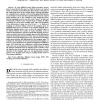Free Online Productivity Tools
i2Speak
i2Symbol
i2OCR
iTex2Img
iWeb2Print
iWeb2Shot
i2Type
iPdf2Split
iPdf2Merge
i2Bopomofo
i2Arabic
i2Style
i2Image
i2PDF
iLatex2Rtf
Sci2ools
TMI
2008
2008
Seamless Warping of Diffusion Tensor Fields
To warp diffusion tensor fields accurately, tensors must be reoriented in the space to which the tensors are warped based on both the local deformation field and the orientation of the underlying fibers in the original image. Existing algorithms for warping tensors typically use forward mapping deformations in an attempt to ensure that the local deformations in the warped image remains true to the orientation of the underlying fibers; forward mapping, however, can also create "seams" or gaps and consequently artifacts in the warped image by failing to define accurately the voxels in the template space where the magnitude of the deformation is large (e.g., Jacobian 1). Backward mapping, in contrast, defines voxels in the template space by mapping them back to locations in the original imaging space. Backward mapping allows every voxel in the template space to be defined without the creation of seams, including voxels in which the deformation is extensive. Backward mapping, how...
| Added | 15 Dec 2010 |
| Updated | 15 Dec 2010 |
| Type | Journal |
| Year | 2008 |
| Where | TMI |
| Authors | Dongrong Xu, Xuejun Hao, Ravi Bansal, Kerstin J. Plessen, Bradley S. Peterson |
Comments (0)

